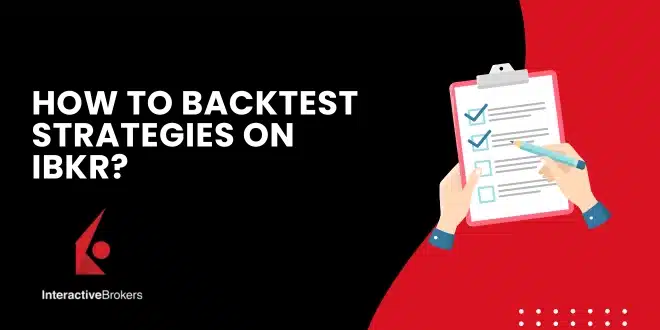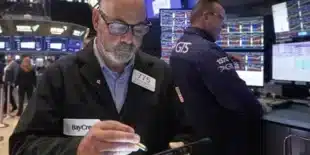Losing money on a strategy you didn’t test properly can feel frustrating — and unnecessary. That’s why learning how to backtest strategies on Interactive Brokers (IBKR) is one of the smartest steps you can take.
Backtesting helps you see how your ideas would have performed in the past, without risking a single dollar.
In this guide, we’ll walk through everything step-by-step — even if you’re brand new to backtesting — so you can start smarter and trade with confidence.
Before you start backtesting
Before you dive into building or testing a strategy, it helps to get organized. A little preparation makes backtesting faster, easier, and more meaningful.
Here’s what you should decide first:
- What market or asset you want to trade. Stocks, forex, options, futures? Each behaves differently.
- What timeframe you’re targeting. Day trading, swing trading, or longer-term investing?
- What goal you want to achieve. Do you want steady gains, low risk, or high growth with more volatility?
- What rules you want to test. Simple moving average crossovers? RSI overbought/oversold signals? Momentum strategies?
Getting clear about these choices first gives your backtesting real focus and purpose.
What is backtesting and why does it matter?
Backtesting means testing a trading strategy on historical market data to see how it would have performed.
It’s like rewinding the market’s history and asking, “What if I had traded this strategy back then?”
Backtesting helps you:
- Find out if your strategy is realistic. A strong idea might look great on paper but fail when tested against real-world conditions.
- Understand potential profits and risks. You’ll learn how much you could win or lose, how often trades succeed, and how big your losses might get.
- Fine-tune your entry, exit, and risk management rules. Even small tweaks — like a tighter stop-loss — can change the outcome dramatically.
Without backtesting, you’re guessing. With backtesting, you’re working with facts.
Ways to backtest on IBKR
Interactive Brokers gives you several ways to backtest, depending on your experience level and needs. The main options are:
- Trader Workstation (TWS) Backtesting: Built-in tool for basic strategy testing.
- IBKR API or third-party software: For deeper, more flexible backtesting with programming.
- Paper Trading (forward testing): Testing strategies live without risking real money.
Each approach has strengths and weaknesses — and we’ll cover how to choose the right one.
How to backtest on IBKR using Trader Workstation (TWS)
IBKR’s Trader Workstation (TWS) has a tool called the Strategy Builder, which lets you backtest without coding.
1. Open Trader Workstation (TWS)
- Download and install the latest TWS platform from the official IBKR website if you haven’t already.
- Log in using your secure credentials.
Always double-check you’re on the official IBKR site to avoid phishing scams. Bookmark the real site for easier, safer access.
2. Set up the Strategy Builder
- Open the New Window menu inside TWS.
- Choose Algo Trading or Strategy Builder.
- Start building a new strategy or select a pre-built template to modify.
You’ll define key components like:
- Entry conditions: Example — Buy when the 50-day moving average crosses above the 200-day moving average.
- Exit conditions: Example — Sell if the stock falls 5% from the entry price or RSI drops below 30.
- Timing rules: Example — Only take trades between 9:30 AM and 3:30 PM to avoid volatile opening and closing periods.
Simple strategies are often easier to manage and improve over time.
3. Run a Backtest
- Once your strategy is set, click Backtest.
- Choose the historical time range you want to simulate (like the past 1 year or 5 years).
- Select the financial instrument you want to test (stocks, ETFs, futures, forex).
Testing across different time periods and market conditions — bullish, bearish, sideways — gives you a more complete view of your strategy’s behavior.
4. Analyze the Results
IBKR TWS will show you:
- Total profit or loss over time. How your account would have grown or shrunk.
- Win rate: Percentage of trades that were profitable.
- Risk metrics: Largest single loss (drawdown) and other volatility measures.
- Detailed trade logs: Every buy and sell action, timestamped.
How to judge your backtest results
When analyzing results, don’t just look at profits. A good backtest must survive the real world too. Here’s what to check:
- Win rate vs reward-to-risk. Winning 60% of trades isn’t great if your losses are twice as big as your wins.
- Maximum drawdown. Could you emotionally survive the biggest loss periods your strategy produces?
- Consistency. Does your strategy perform decently across different markets and times, not just a perfect year?
- Trade frequency. Too many trades might generate high commissions and slippage costs in real trading.
How to backtest using the IBKR API or external platforms
If you want deeper backtesting control, IBKR’s API or third-party tools open up much more power — but also more complexity.
You can use:
- IBKR API with Python: Libraries like Backtrader or Zipline let you write and test automated strategies.
- Third-party platforms: Services like QuantConnect, Amibroker, or NinjaTrader offer visual interfaces, deeper datasets, and integration with IBKR.
This setup allows you to:
- Backtest multi-asset portfolios. Mix stocks, futures, currencies, and options together.
- Model realistic trading conditions. Include slippage, commissions, and execution delays.
- Build complex, algorithmic systems. Try statistical arbitrage, machine learning, or multi-indicator models.
Many intermediate and professional traders recommend starting with visual platforms first, then learning basic Python if you want full control.
How to “forward test” with IBKR Paper Trading
Paper trading is a form of forward testing — where you trade live markets using simulated money.
How to set it up:
- Log into your IBKR account management portal.
- Request access to a Paper Trading account (free for all IBKR users).
- Log into the Paper Trading version of TWS and trade in real-time.
Forward testing helps you:
- See your strategy in action. Understand how quickly you can react in real markets.
- Spot technical issues. Some strategies that work on paper break when facing real bid-ask spreads.
- Test your emotions. Real trading is as much about psychology as math.
Many real traders backtest historically, forward test with paper trading, then cautiously start small with real money.
Important mistakes to avoid when backtesting
- Ignoring slippage and trading costs. Real trades almost never happen exactly at the price you want.
- Overfitting. Creating a strategy that looks “perfect” for the past but fails in the future.
- Look-ahead bias. Accidentally using future information to make past decisions. Always design strategies based only on information that would have been available at the time.
- Data snooping. Trying dozens of tweaks until something works by luck, not logic.
True testing means being honest — not trying to create the prettiest curve.
Final thoughts: How to backtest strategies on IBKR
Backtesting strategies on IBKR is a powerful way to turn ideas into reliable trading plans. It helps you avoid emotional guesswork, reduces costly mistakes, and builds the confidence you need to succeed.
Whether you start by using Trader Workstation for simple strategies, dive into IBKR’s API for more control, or forward-test carefully with Paper Trading, the key is to take your time, learn from mistakes, and improve your process step-by-step.
Every serious trader you admire today has one thing in common: they backtested, adapted, and stayed patient.
Learning to backtest well isn’t just a skill — it’s a key to unlocking your potential.
You’re building the same habits that create long-term trading success. Keep going.
FAQs
1. Can I backtest strategies directly in the IBKR mobile app? No. The IBKR mobile app does not support backtesting. You’ll need to use Trader Workstation (TWS) or external platforms connected to IBKR.
2. Is the backtest feature free to use for IBKR clients? Yes. Using Strategy Builder and running basic backtests inside TWS is free for all Interactive Brokers clients.
3. How accurate is IBKR’s built-in backtesting? It’s fairly accurate for simple strategies, but it doesn’t always fully simulate real-world factors like slippage, trading fees, and changing liquidity.
4. Can I backtest options strategies on IBKR? Yes, you can backtest basic options trades like single puts or calls inside TWS. However, more complex multi-leg strategies (like spreads or straddles) may require third-party tools for full simulation.
5. Do I need to know coding to backtest effectively? Not for simple strategies. But if you want to automate, customize, or scale your testing across many assets, learning basic Python helps a lot.
6. Is paper trading enough instead of backtesting? Paper trading shows how your strategy works live but doesn’t give you long-term historical data. Best practice is to backtest first, then forward test through paper trading.
7. How far back can I backtest using IBKR data? IBKR provides several years of historical data for many stocks, ETFs, futures, and currencies. Depth and quality vary by asset type, so check data availability for your specific needs.
Can I automate trading based on my backtested strategy? Yes. If you create a strategy using the IBKR API or supported third-party platforms, you can automate execution based on your backtested plan.


